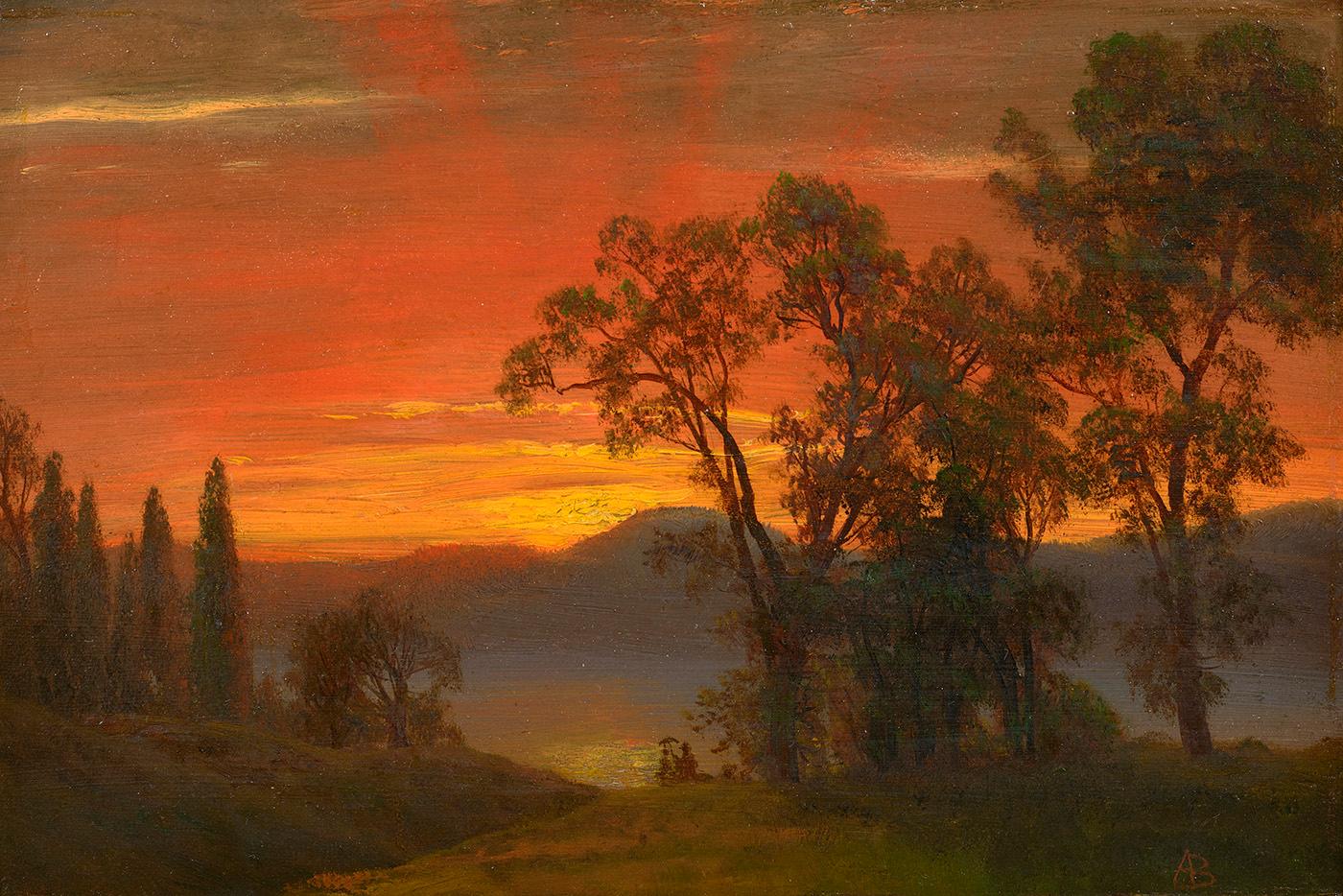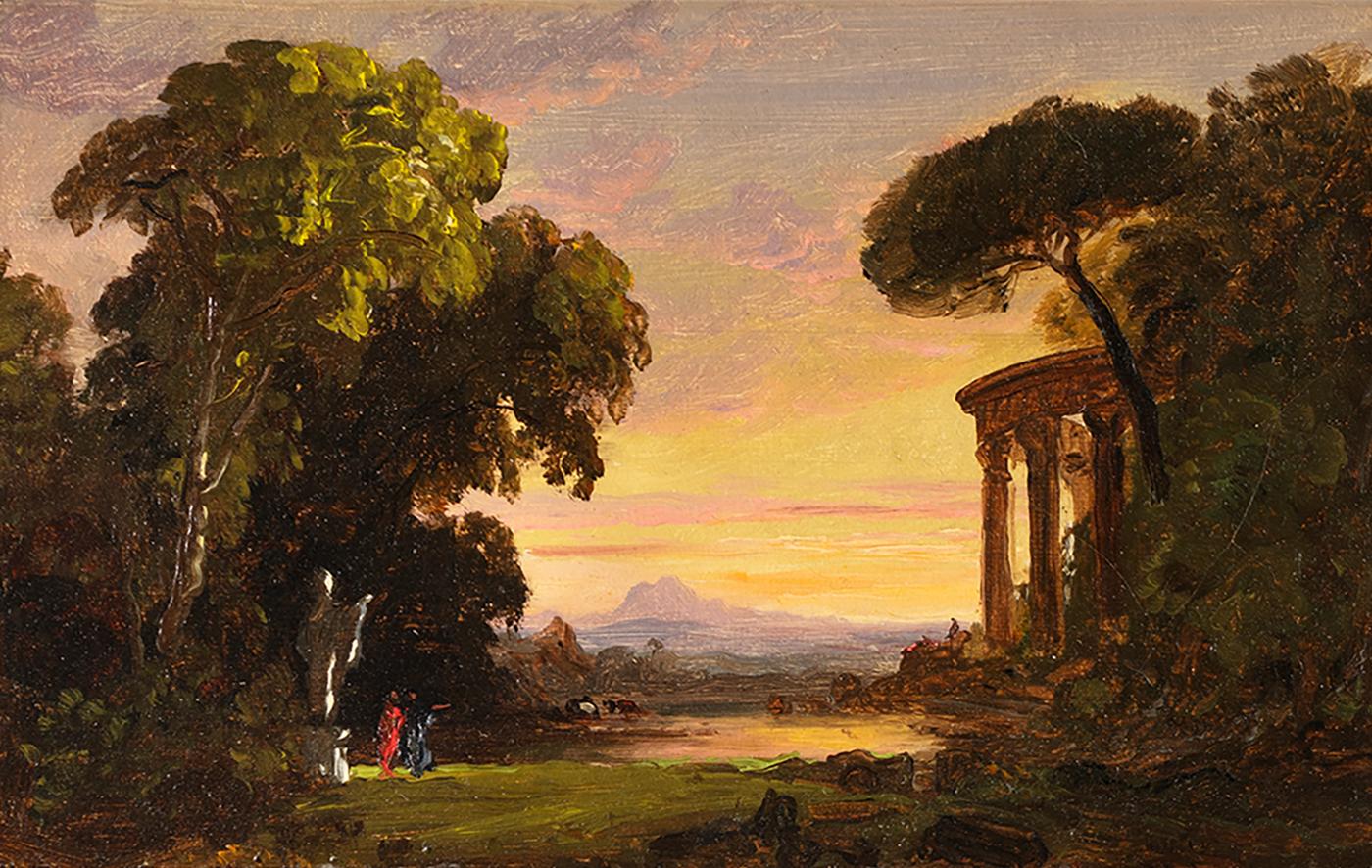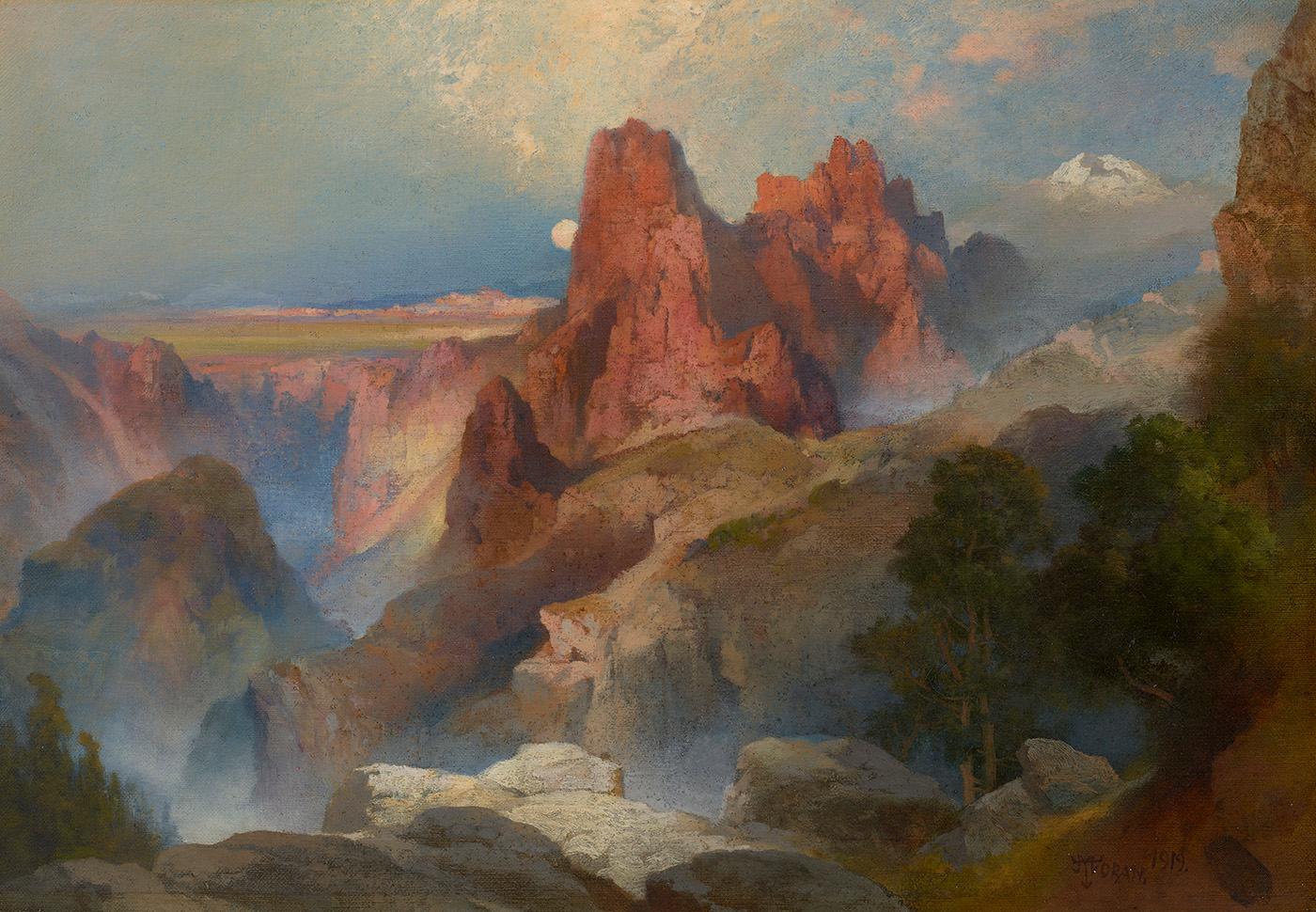Items Similar to "White House and Trees, " John Frederick Kensett, Hudson River School, New Jersey
Want more images or videos?
Request additional images or videos from the seller
1 of 7
John Frederick Kensett"White House and Trees, " John Frederick Kensett, Hudson River School, New Jerseycirca 1853
circa 1853
About the Item
John Frederick Kensett
White House and Trees, circa 1853
Oil and gouache on paper
6 3/4 x 9 3/4 inches
Provenance:
Estate of Vincent Colyer (1824 - 1888)
By descent
Paul Magriel Collection
Private Collection, Long Island
Exhibited:
New York, The Finch College Museum of Art; Southampton, New York, The Parrish Art Museum; New Orleans, Louisiana, Isaac Delgado Museum of Art; Norfolk, Virginia, Norfolk Museum of Art; Montclair, New Jersey, Montclair Art Museum; New London, Connecticut, Lyman Allyn Museum; Manchester, New Hampshire, The Currier Gallery of Art; Providence, Rhode Island, Rhode Island School of Design; Youngstown, Ohio, The Butler Institute of American Art, American Drawings (Benjamin West to the present) from the Paul Magriel Collection, June 1961 - December 1962.
Portland, Oregon, Portland Art Museum, April 14 - May 15, 1963.
Boston International Fine Art Show at the Cyclorama, Lincoln Glenn, October 19 - 23, 2022.
In the 1850s through 1860, John Frederick Kensett, painted a series of at least five landscapes of the "Shrewsbury River" (now the Navesink River) along the New Jersey shore. Art historians have described Kensett’s paintings of the river as having evolved from a trip in the fall of 1853 at the invitation of Kensett's friend, author and lecturer George Curtis. However, letters viewable at the Smithsonian Archives of American Art website make it clear that Kensett had become acquainted with the area over a year earlier, most likely in connection with fellow artist and friend Thomas Prichard Rossiter.
Kensett and Rossiter had been friends since at least the 1830s. As aspiring artists, they had traveled to Europe together in the 1840s. In 1851 Rossiter married Anna Ehrick Parmly, then in her early 20s, and Kensett attended the wedding. Anna was one of four daughters of Eleazer and Anna Maria Parmly. Eleazer, one of the major figures in American dentistry history, was a wealthy and accomplished member of New York society.
When not in the city, the Parmly family gathered at Bingham Place, a sprawling estate on 275 pastoral acres spanning the peninsula between the Shrewsbury and Navesink Rivers along the New Jersey shore. The Bingham Place estate encompassed much of what is now Rumson, then known as Oceanic, N.J. It was a wide-open landscape of ocean views, orchards, lawns, and cattle-dotted pastures. There the Parmlys opened their doors to family, friends, and the summer breeze.
Rossiter, newly-married into the Parmly family, was likely the reason that Kensett paid a social visit to Bingham Place in the summer of 1852. On July 11, 1852, having reluctantly departed, Kensett wrote Rossiter who was still at Bingham Place:
New York to me now is that of a deserted place…marking a dismal contrast to the green lawns at Bingham Place. I saw the receding shores of Shrewsbury & the line of dust which marked your homeward course & finally the last glimpse of the Locust trees that shade the pleasant mansion & happy inmates at Bingham with any thing but a joyous spirit.
A major figure in the American luminist tradition and one of the most renowned painters of the Civil War era, John Frederick Kensett was born in Cheshire, Connecticut, in 1816. He was the son of Thomas Kensett, a British immigrant engraver, and it was in his father's New Haven firm that Kensett first learned to draw.
After mastering the rudiments of the graphic arts, he worked as an engraver in print shops in New Haven, Albany, and New York throughout the 1830's. During this period, he began to paint on his own, encouraged by a friend and fellow artist, John W. Casilear. In 1838, he made his first submission, a landscape, to the annual exhibitions of the National Academy of Design.
Desirous of continuing his training, Kensett traveled to Europe in 1840. For the next seven years, often in the company of artists such as Casilear and Asher B. Durand, he painted and sketched in France, England, Italy, and Switzerland. In 1846, he sent several of his Italian landscapes back to New York, the American Art-Union purchasing two of them.
Returning to New York in 1847, Kensett's career soon began to flourish. He was elected an Associate member of the National Academy in 1848 and reached full Academician status only a year later. It was around this time that he began to make summer sketching trips to the Catskills, the White Mountains, and Adirondacks and to the Newport coast, a practice that he would continue throughout his life. Although he later made several journeys to the American West and Europe, he was most drawn to the mountains, lakes, woods, and beaches of the American Northeast.
Kensett's stylistic approach of the 1850's had its basis in the classical, topographically-detailed landscapes of the first generation Hudson River School. However, during the 1860's, he began to take a greater interest in the effects of light, air and atmosphere. He integrated these concerns into quiet, well-structured land and seascapes characterized by tight brushwork and a subdued palette yet endowed with a unique poetic lyricism -- traits that later led one critic to refer to him as "the Bryant of our painters."
This venue, echoed in the work of Kensett's contemporaries -- Martin Johnson Heade, Sanford Gifford, and Fitz Hugh Lane -- has since been identified as "luminism." Kensett's landscape subjects ranged from the quiet, woodland interiors of New York and New England to the long, uninhabited shorelines of the Atlantic seaboard, making him the first member of the second generation Hudson River School painters to depict the seashore.
One year prior to his death, he completed an important series of thirty-eight paintings of Long Island Sound which are now in the collection of the Metropolitan Museum.
A prolific and popular artist, Kensett was also an active participant in the local and national art life of his day. In 1859, he was appointed to the U.S. Capitol Art Commission. Four years later he helped organize the Sanitary Fair exhibition in support of the Union Troops. He also established the Artists Fund Society (1865) and in 1870 was a founding member of the Metropolitan Museum.
John Frederick Kensett died in his New York studio in 1872.
- Creator:John Frederick Kensett (1816-1872, American)
- Creation Year:circa 1853
- Dimensions:Height: 12 in (30.48 cm)Width: 15 in (38.1 cm)
- Medium:
- Movement & Style:
- Period:
- Condition:
- Gallery Location:New York, NY
- Reference Number:1stDibs: LU1841211648672
About the Seller
5.0
Platinum Seller
These expertly vetted sellers are 1stDibs' most experienced sellers and are rated highest by our customers.
Established in 2021
1stDibs seller since 2022
63 sales on 1stDibs
Typical response time: <1 hour
- ShippingRetrieving quote...Ships From: Larchmont, NY
- Return PolicyA return for this item may be initiated within 3 days of delivery.
More From This SellerView All
- "North Conway Farm, " Edward Hill, White Mountain School Antique Landscape ViewBy Edward HillLocated in New York, NYEdward Hill (1843 - 1923) Haying at a North Conway Farm with Mount Washington in the Distance, New Hampshire Oil on canvas 13 1/2 x 20 1/2 inches Signed lower right Provenance: Private Collection, Dallas, Texas Born in Wolverhampton, England in 1843, Edward Hill was the ninth of ten children. Though ultimately less well known than his older brother Thomas Hill (1829-1908), Edward was a productive painter in oil and watercolor for more than sixty years, producing images of the White Mountains of New Hampshire, southern genre scenes, still-life paintings, portraits, American Indian pictures...Category
Late 19th Century Hudson River School Landscape Paintings
MaterialsCanvas, Oil
- "Birch Tree in Maine, " Hudson River School Antique Landscape, White MountainsBy Harrison Bird BrownLocated in New York, NYHarrison Bird Brown (1831 - 1915) Birch Tree in Maine, New England, 19th Century Oil on canvas 25 x 13 1/8 inches Initialed lower left Provenance: Portland International Galleries, Maine Mr. and Mrs. Walter M. Jeffords, Jr., Saratoga Springs, New York and Lexington, Kentucky (President of Brooklyn Borough Gas Company) Private Collection, Chicago Exhibited: Portland Maine, Portland Museum of Art, 58 Maine Paintings 1820-1920: Selections from the Collection of Mr. and Mrs. Walter M. Jeffords, Jr., May 20 - June 20, 1976, cat. no. 11. The above catalogue listing this vertical landscape will be included with your purchase. "Mr. Brown has succeeded fully in accomplishing that which Mr. John Ruskin, in speaking of J. M. W. Turner's sea views, said no painter had yet accomplished; that is, the representation of the creamy foam which the storm lashes up from the waves along a rocky shore." Harrison Bird Brown was born in 1831 in Portland, Maine, and is best known for his White Mountain landscapes and marine paintings of Maine...Category
Late 19th Century Hudson River School Landscape Paintings
MaterialsOil, Canvas
- "West Point" John Ferguson Weir, Hudson River School Landscape with SailboatsBy John Ferguson WeirLocated in New York, NYJohn Ferguson Weir West Point, 1873 Signed and dated lower left Oil on panel 12 1/8 x 20 1/8 inches Provenance: Sotheby's Arcade, American Paintings, December 19, 2003, Lot 1091 Spanierman Gallery, New York Private Collection, New York (acquired directly from the above) Exhibited: Roslyn, Nassau County Museum of Fine Art, William Cullen Bryant, The Weirs and American Impressionism, April 24, 1983-July 31, 1983. A painter, sculptor, writer, and teacher, John Weir was a highly talented man whose painting was overshadowed by his father, Robert Weir, the long-time West Point Academy drawing teacher, and his brother, J Alden Weir, well-known impressionist painter. His distinguished reputation was primarily based on his accomplishments as a teacher and administrator. For many years, from 1869 to 1913, John Weir was the Director of the Yale University School of Fine Arts. He was also a commissioner of the art exhibition at the Centennial Exposition in Philadelphia. Weir was born at West Point, New York, and by age 20, had a studio in New York City in the Tenth Street Studio Building, the first building in America dedicated to art studios, and there he associated with many leading painters of the day. He earned attention early in his career for paintings of industrial scenes...Category
1870s Hudson River School Landscape Paintings
MaterialsPanel, Oil
- "Water Stop" Thomas Hill, Hudson River School Landscape with Horses and RoadBy Thomas HillLocated in New York, NYThomas Hill Water Stop, 1853 Signed and dated lower left Oil on canvas 14 x 20 inches Provenance: Arader Galleries, New York Immigrating from England ...Category
1850s Hudson River School Landscape Paintings
MaterialsCanvas, Oil
- "Grand Manan" Harrison Bird Brown, Maine Landscape, Hudson River School SeascapeBy Harrison Bird BrownLocated in New York, NYHarrison Bird Brown (1831 - 1915) Grand Manan Oil on canvas 12 x 20 inches Signed with initials lower left Harrison Bird Brown was born in 1831 in Portland, Maine, and is best known for his White Mountain landscapes and marine paintings of Maine's Casco Bay...Category
Late 19th Century Hudson River School Landscape Paintings
MaterialsCanvas, Oil
- "Hubbard Park, Crescent City, Florida" George Frederick Morse, LandscapeLocated in New York, NYGeorge Frederick Morse Hubbard Park, Crescent City, Florida, 1906 Oil on canvas 17 x 12 inches A landscape and marine painter from Portland, Maine, George Morse was a founding membe...Category
Early 1900s Hudson River School Landscape Paintings
MaterialsCanvas, Oil
You May Also Like
- Sunset over the RiverBy Albert Bierstadt, 1830-1902Located in New York, NYMonogrammed lower right: ABCategory
Mid-19th Century Hudson River School Landscape Paintings
MaterialsPaper, Oil, Board
- Fairhaven Harbor (Old Tack Works Wharf)By William BradfordLocated in New York, NYSigned lower right: BradfordCategory
19th Century Hudson River School Landscape Paintings
MaterialsOil, Paper, Board
- Ruins with FiguresBy Jasper Francis CropseyLocated in New York, NYFamed Hudson River School painter and architect.Category
19th Century Hudson River School Landscape Paintings
MaterialsPaper, Canvas, Oil
- Grand CanyonBy Thomas MoranLocated in New York, NYMonogrammed and dated lower right: TMORAN. 1919.Category
20th Century Hudson River School Landscape Paintings
MaterialsOil
- Niagara FallsBy Régis François GignouxLocated in New York, NYSigned lower left: R. GignouxCategory
19th Century Hudson River School Landscape Paintings
MaterialsOil
- Autumn Idle, Catskills, New York, October 23, 1885By Jervis McEnteeLocated in Missouri, MOAutumn Idle, Catskills, New York, October 23, 1885 By. Jervis McEntee (American, 1828-1891) Unframed: 11.5" x 16" Framed: 20.5" x 25" Jervis McEntee was a landscape painter, born in 1828 in the Hudson River Valley in Rondout, New York. It was said that 'Nostalgia may well have been McEntee's middle name", and that he, always attempting to stir emotions in his viewers, often attached poetry to his paintings when exhibiting them. At a time when the Civil War and its after effects caused great disruption in America, McEntee's work may have provided a visual escape for the more educated. His works are rich with the colors of autumn and winter, and he, who often painted in the Catskill Mountains, preferred smaller views rather than panoramas. Usually detailed and simple, his works often reflect a sense of loneliness. As a youngster, McEntee would play in his parents attic, pretending it was an art studio. An unsuccessful attempt at business led McEntee back into the art profession where he studied in New York City under the influence of Frederic E. Church, master of the Hudson River Style, and soon had a showing of his own in the famous Tenth Street Studio Building by 1855. In about 1858, Mr. and Mrs. McEntee hired English architect Calvert Vaux to build a studio next to McEntee's fathers house in Rondout. There Jervis would spend most of his summers, painting the nearby Catskill Mountains, and returning to the city during the winter. At the outbreak of the Civil War, McEntee enlisted in the Union...Category
Late 19th Century Hudson River School Landscape Paintings
MaterialsOil, Canvas
Recently Viewed
View AllMore Ways To Browse
House Of Antiques
Antique New England Art
Antique White House
London River
Antique School House
Rivers Of London
Spirit House
Happy New Year
New Jersey Landscape
Hudson Oil
School Antiques
New England Antiques
Antique School Light
Oil Painting New Jersey
Weller Hudson
West Jersey
Painting Of Rivers And Trees
Tree Lined Painting





